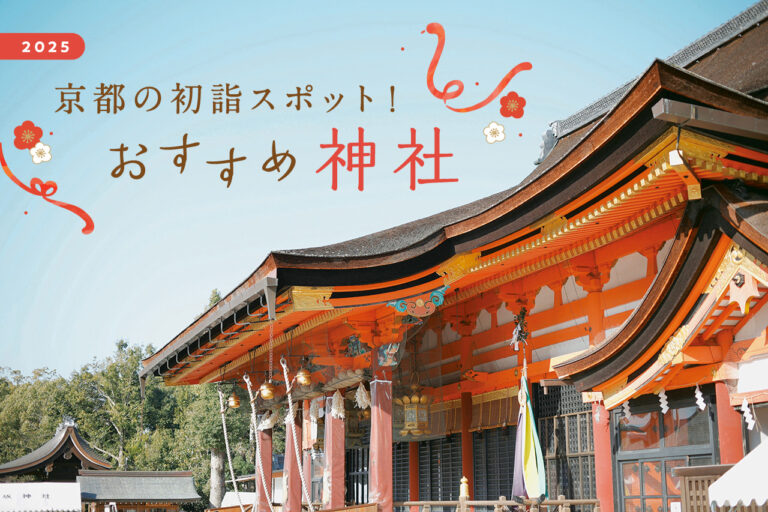
[2025] Hatsumode Spots in Kyoto! 12 recommended shrines
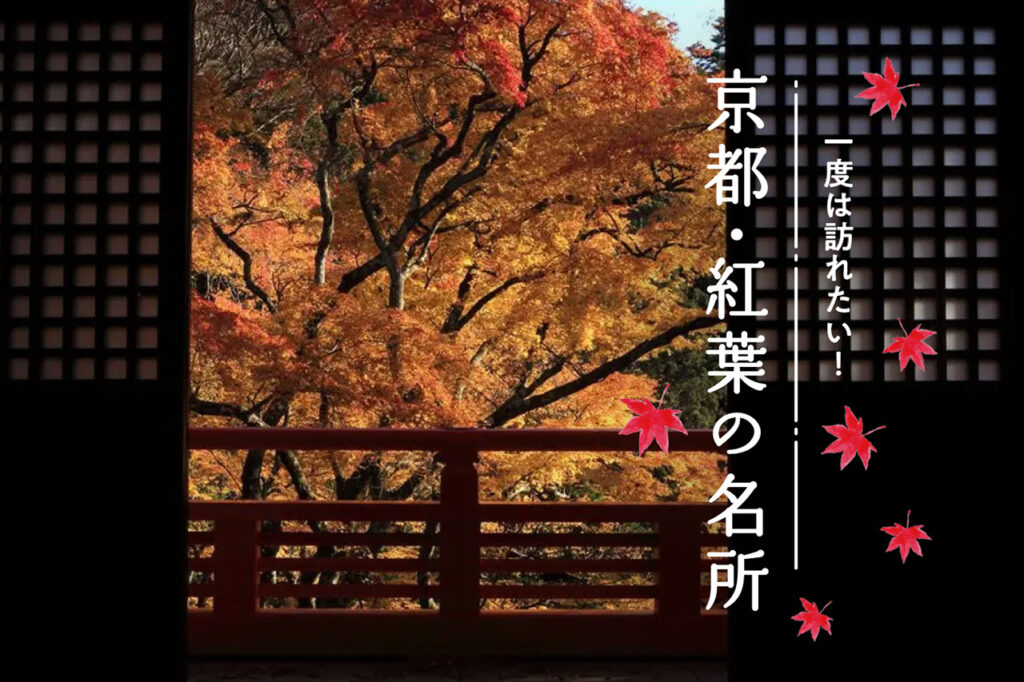

Kyoto is dotted with many places famous for their autumn foliage, and as autumn deepens, you will encounter beautiful autumn leaves.
This time, we will introduce you to the latest autumn foliage spots in Kyoto in 2021, from classic autumn foliage spots to hidden gems, where you can drop by on your days off or even after work or school! We will introduce you to the latest autumn foliage spots in Kyoto in 2021, from classic autumn foliage spots to hidden gems.
*Please check the official website and SNS in advance to confirm whether the event will be held or not.
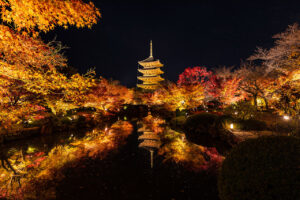
In this issue, we will introduce you to Kyoto's autumn foliage and illumination spots, from the classic spots to the more obscure ones.
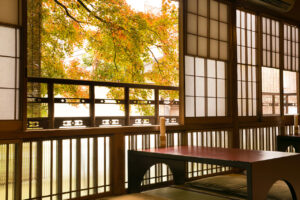
Introducing 5 restaurants with a view of autumn leaves to further enjoy the autumn foliage season. Enjoy the luxurious view and feel the autumn in Kyoto.
Tofukuji Temple is the head temple of the Tofukuji School of the Rinzai Sect of Zen Buddhism and boasts a magnificent temple complex.
About 2,000 maple trees, including Irohamomiji and Yama-momiji, brightly decorate the temple grounds. The magnificent view of the valley and Isatama-kan from the Tsutenkyo Bridge is especially beautiful and overwhelming.
Best time to see/ Usually mid-November to late November
Visiting hours
End of Apr. to Oct. / 9:00 - 16:30 (last admission at 16:00)
First Sunday of November-December / 8:30-16:30 (last admission / 16:00)
First Sunday in December through the end of March / 9:00 - 16:00 (last admission at 15:30)
Regular admission fee
Tsutenkyo/Kaizando/adults 600 yen, children 300 yen
Tofukuji Honbo Garden (Hojo) / Adults 500 yen, Children 300 yen
Tofukuji Temple Honbo Garden (Hojo), Tsutenkyo Bridge, Kaisando (common entrance ticket)/Adults 1000 yen, Children 500 yen
Fall admission fee: Nov. 10 - Nov. 30
Tofukuji Honbo Garden (Hojo) / Adults 500 yen, Children 300 yen
Tsutenkyo Bridge and Kaisando / Adults 1,000 yen, children 300 yen
There is no common worship ticket available.
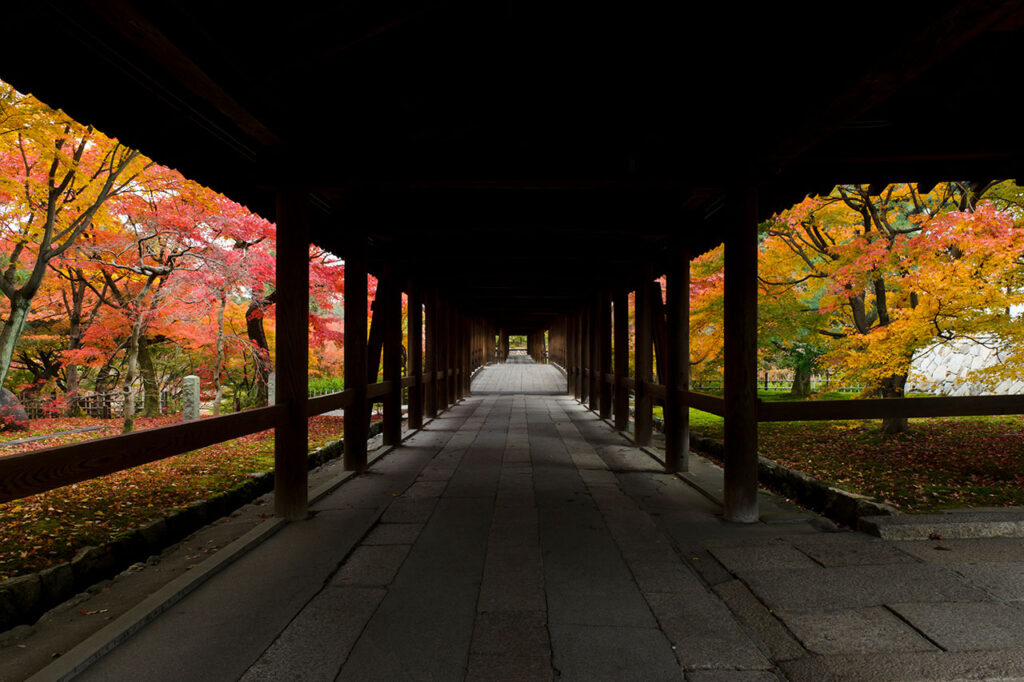

Unryu-in Temple was built by Emperor Go Kogon as a branch temple of Sennyu-ji Temple, a family temple of the imperial family.
During the fall foliage season, the reddish hues of the leaves delight the eyes of visitors from the picturesque "Shikishi Window" as well as from the rooms with the "Window of Enlightenment" and the "Window of Lostness".
Best time to see/ Usually mid to late November
Visiting hours9:00-17:00 (last admission at 16:00)
admission fee/400 yen
Autumn special viewing/November 19 (Friday) to 23 (Tuesday)
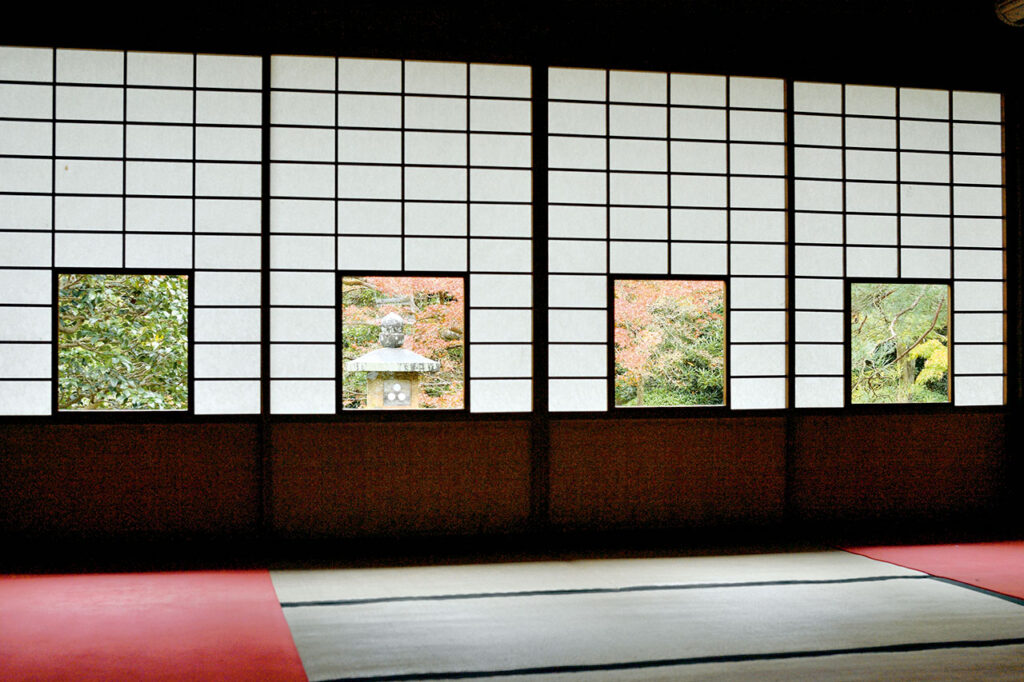

Officially called "Zenrin-ji Temple," [Eikando] was originally built by monk Shinshao, a disciple of Kobo Daishi (Kukai), as a center for Shingon esoteric Buddhism.
It has been called "Eikando of maple trees" since ancient times and is famous for its autumn foliage. During the season, approximately 3,000 maple trees brightly decorate the pond garden and the pagoda.
Best time to see/ Usually mid to late November
Visiting hours9:00-17:00 (last admission at 16:00)
admission fee600 yen for adults, 400 yen for elementary, junior high and high school students (1,000 yen during the autumn exhibition of temple treasures)
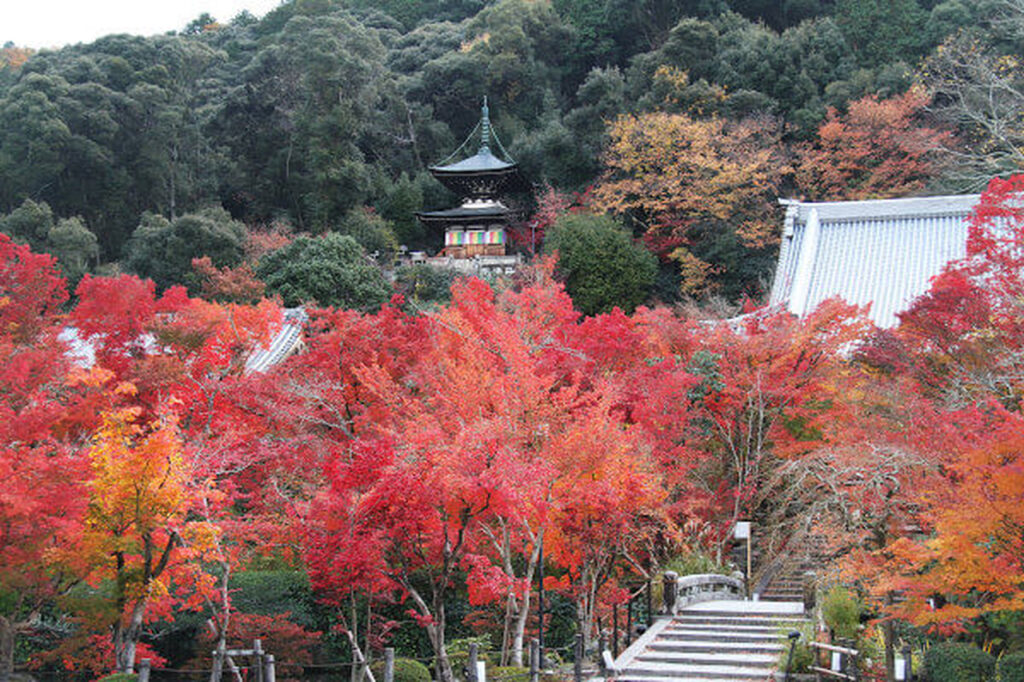

Nomiya Shrine is known as the god of marriage.
In autumn, the sky is decorated with maple trees, which contrast fantastically with the black wooden torii gate. One can recall the autumn foliage viewing that must have been enjoyed by the aristocrats of the Heian period (794-1192).
Best time to see/ Usually mid to late November
Visiting hours/9:00-17:00
admission feeFree of charge
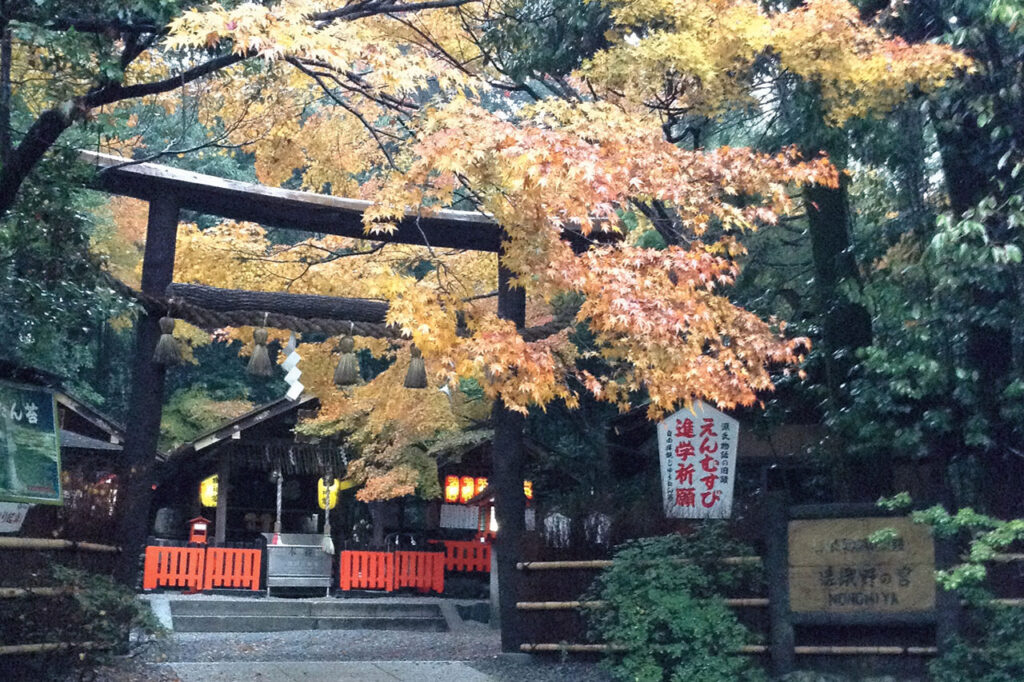

Rebuilt by Chikayoshi Imaeda of the Kaga Maeda clan in the early Edo period.
During the fall foliage season, the pillars of the shoin are likened to a picture frame, and the view of the pond garden is exceptional.
Best time to see/ Usually mid to late November
Visiting hours/9:00-17:00
admission fee/400 yen
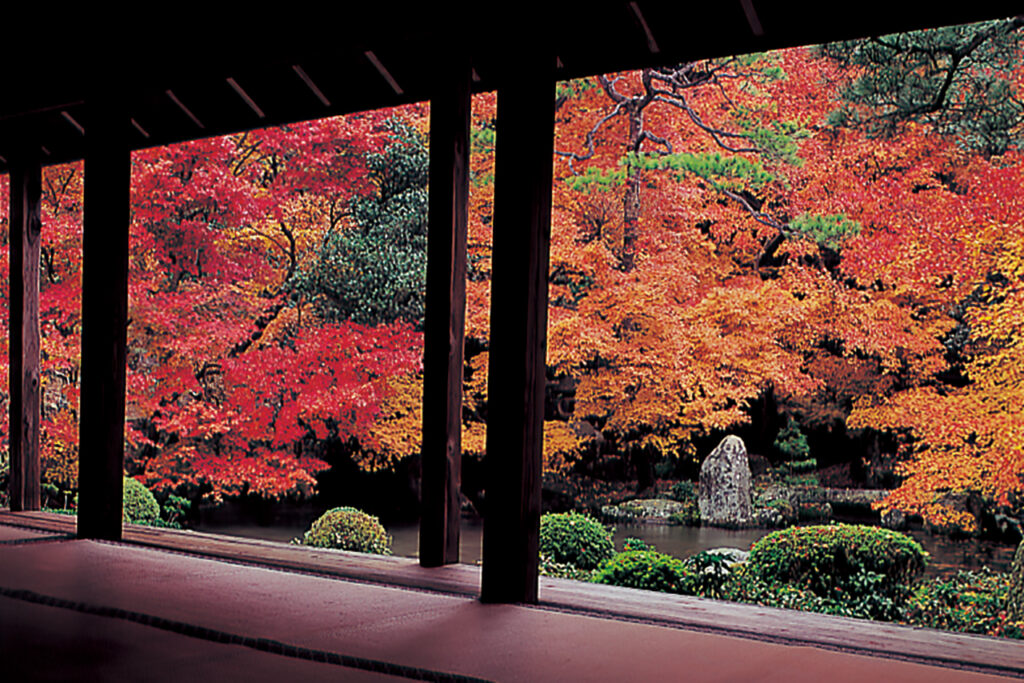

Jingo-ji Temple is associated with Kukai, the founder of Japan's esoteric Buddhism.
During the autumn foliage season, the contrast between the blue of the moss and the red of the foliage looks beautiful.
Best time to see/ Usually mid to late November
Visiting hours/9:00~16:00
admission fee600 yen for adults (junior high school students and older), 300 yen for elementary school students
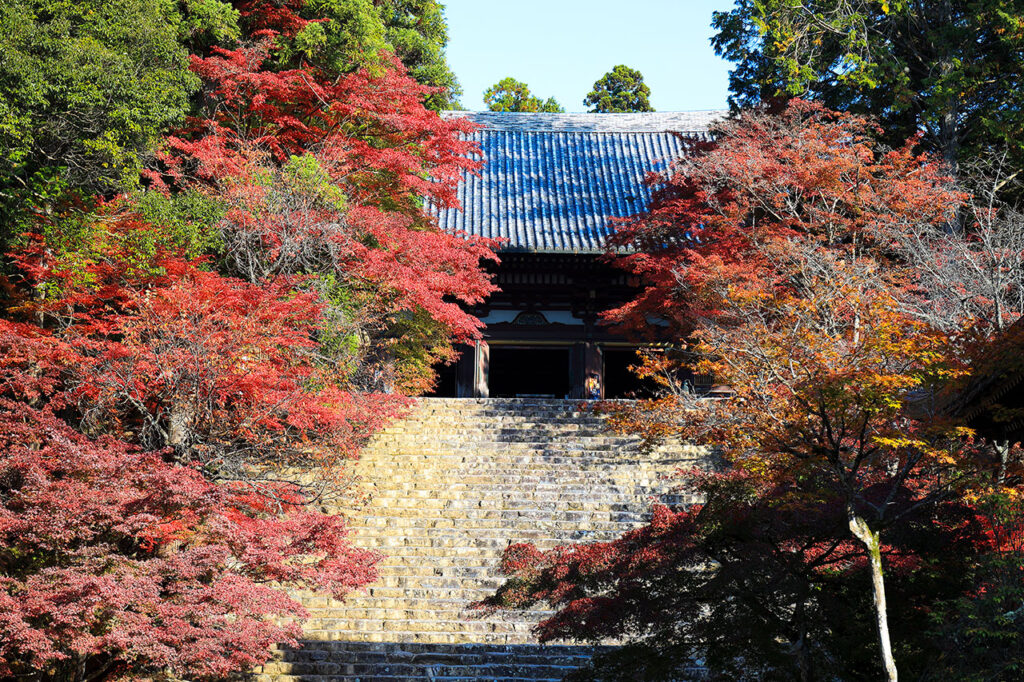

Saimyoji Temple was founded by Chisen Shonin, a nephew of Kobo Daishi, who was associated with Jingoji Temple, as a training center for young monks.
It is also known for its spectacular natural scenery, which changes with the seasons: cherry blossoms and mountain azaleas in spring, fresh greenery in summer, autumn leaves in fall, and snowy landscapes in winter.
Best time to see/ Usually early to late November
Visiting hours/9:00-17:00
admission feeAdults: 500 yen, Junior high and high school students: 400 yen
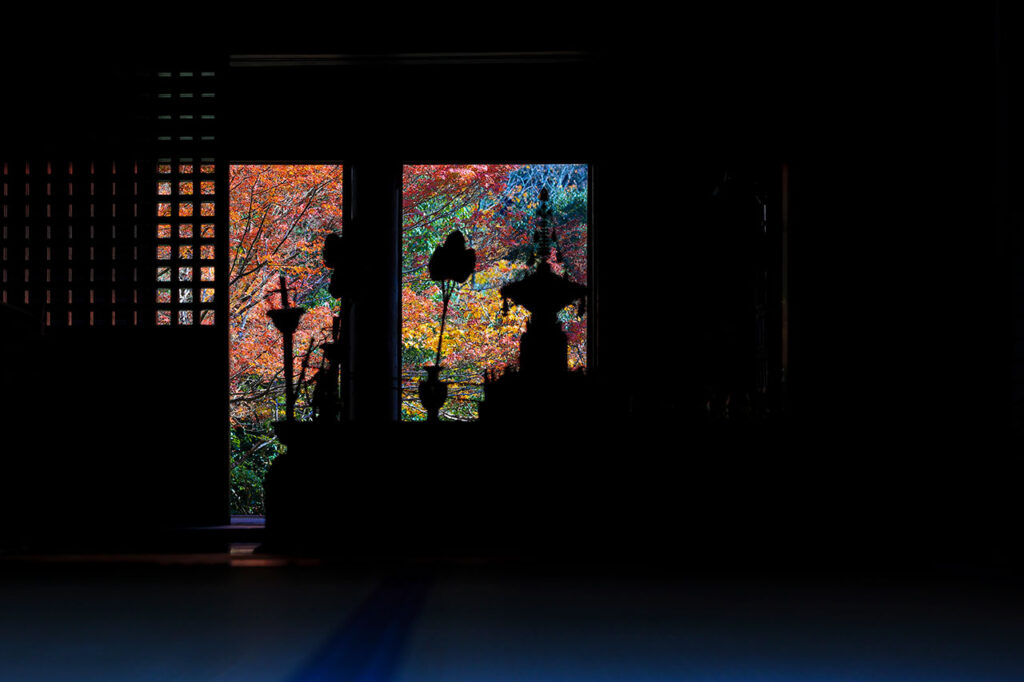

Kibune Shrine is dedicated to the deity Takakami-no-mikoto, who is in charge of water supply.
When the autumn leaves are lit up, the maple trees illuminated by the lights radiate a different beauty from that of the daytime.
Best time to see/ Usually early to late November
opening time of the gate/ 6:00 - 20:00 *During the "Kibune Maple Lantern Festival," November 06 (Sat.) - 28 (Sun.) - 20:30
Kibune Maple Lanterns in Kyoto/ November 06 (Sat) - 28 (Sun)
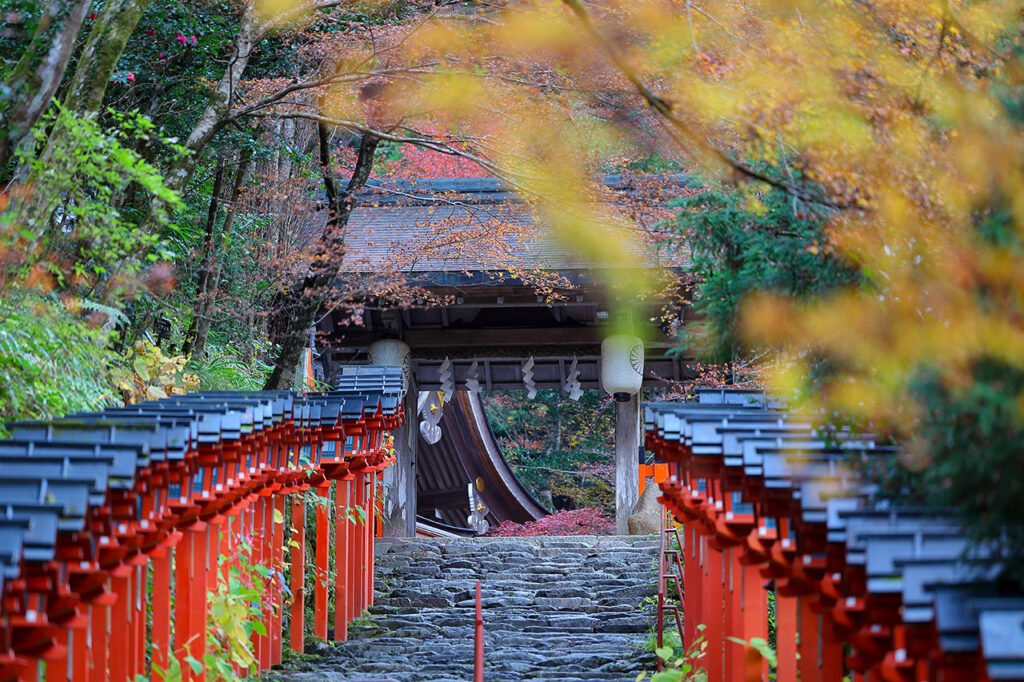

Kuramadera Temple is known as the place where Ushiwakamaru trained and is the most powerful spot in Kyoto.
The best time to view the leaves is usually from early to late November. From the Niomon Gate to the 99-fold approach, through the Tenporin-do Hall to the main Kondo Hall, visitors will be enchanted by the various expressions of the autumn leaves brought about by the abundant nature of Kurama Mountain.
In particular, the autumn leaves that brightly decorate the vermilion Niomon gate and the approach leading to the main shrine are a must-see beauty.
Best time to see/ Usually early November to late November
Opening Hours of the Main Hall/9:00~16:15
Reihouden (Kuramayama Museum) Opening Hours/9:00~16:00
Closed on Mondays (or the following day if Monday is a national holiday), and closed from December 12 to the end of February.
Ficus pumila var. awkeotsang (variety of climbing fig)300 yen
Reihouden (Kuramayama Museum) Admission200 yen
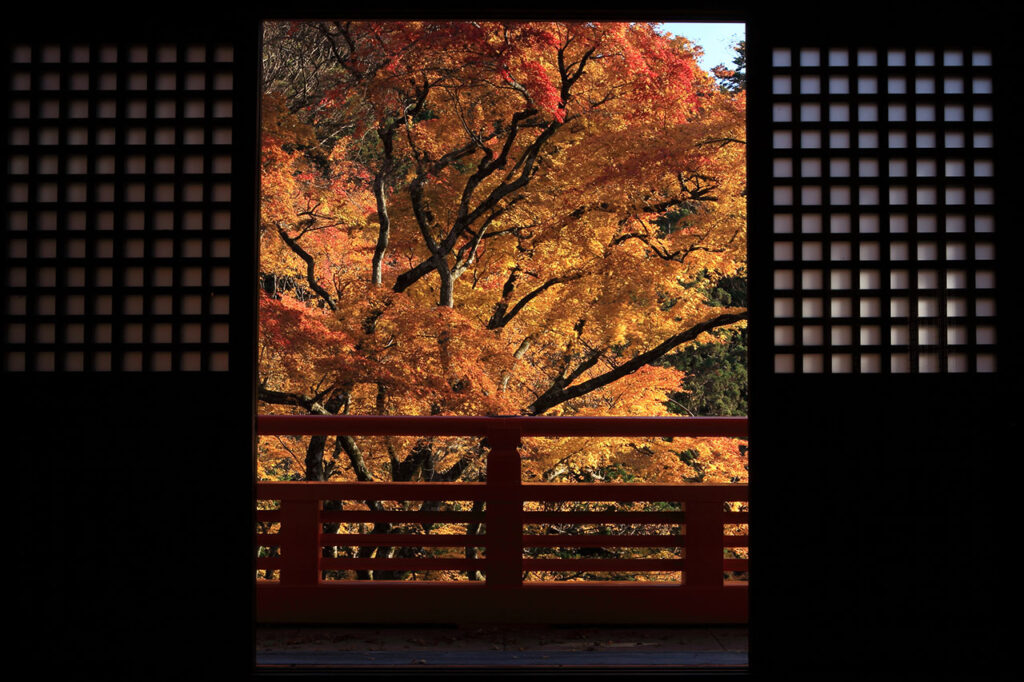

The temple's name comes from the Buddhist term "jojakko-do," meaning the most idealistic place in the world where the Buddha lives [jojakkoji].
The approach to the 12-meter-high Daboto (pagoda), which rises behind the main hall, is decorated with autumn leaves and offers a spectacular view of the city of Kyoto and, if the weather permits, Mt.
Best time to see/ Usually mid to late November
Hours of Prayer/ 9:00 - 17:00 (Reception close / 16:30)
admission fee/500 yen
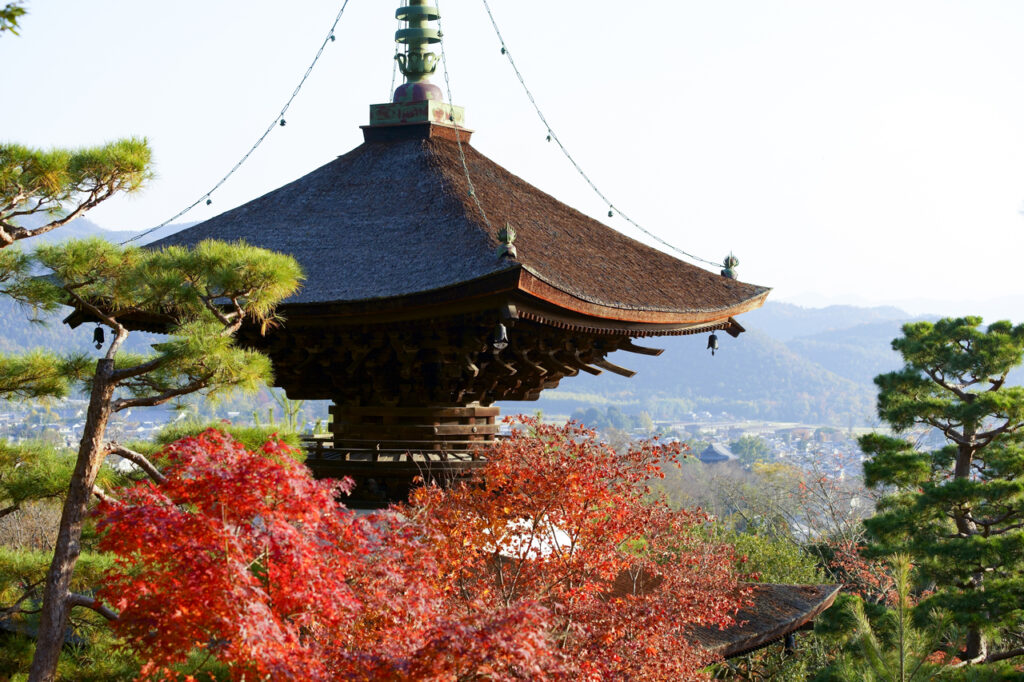

Sanzenin Temple in Ohara is known for its famous garden "Arikien Garden" with its beautiful cedar grove and moss.
Surrounded by mountains, the temple offers seasonal scenery. The leaves usually change color from mid to late November, and the maple trees in the Juhokuen Garden, another garden, turn brilliant colors. The sight of red and orange leaves falling on the moss is exceptionally beautiful.
Best time to see/ Usually mid-November to late November
Visiting hours/ 9:00-17:00 (November / 8:30-17:00, December-February / 9:00-16:30)
admission feeAdults 700 yen, Junior and senior high school students 400 yen, Elementary school students 150 yen
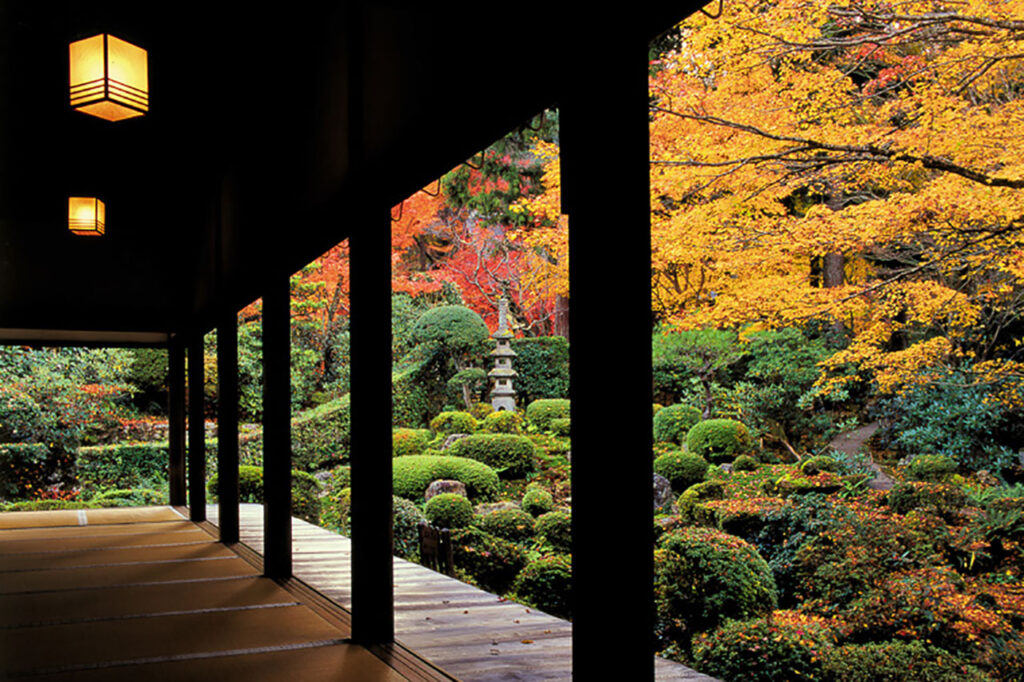

The place where Honen first preached the teaching of Nembutsu [the Buddha's prayer] [Koumyouji Temple].
The vast precincts of the temple are dyed bright red, overwhelming visitors. In particular, the scattered autumn leaves that color the stone pavement on the women's slope and the tunnel of autumn leaves along the maple approach are breathtakingly beautiful and must-see.
Best time to see/ Usually mid-November to late November
Visiting hoursFree access to the precincts/precincts. 18:00 closing, Mikageido 9:00-16:00.
*Special autumn foliage entrance period: 9:00-16:30 (registration closes at 16:00)
mountain entry feeFree of charge
Special admission period for autumn foliage: 1,000 yen for adults (high school students and older), 800 yen for groups (20 people and over)
600 yen if you make a group reservation in advance.
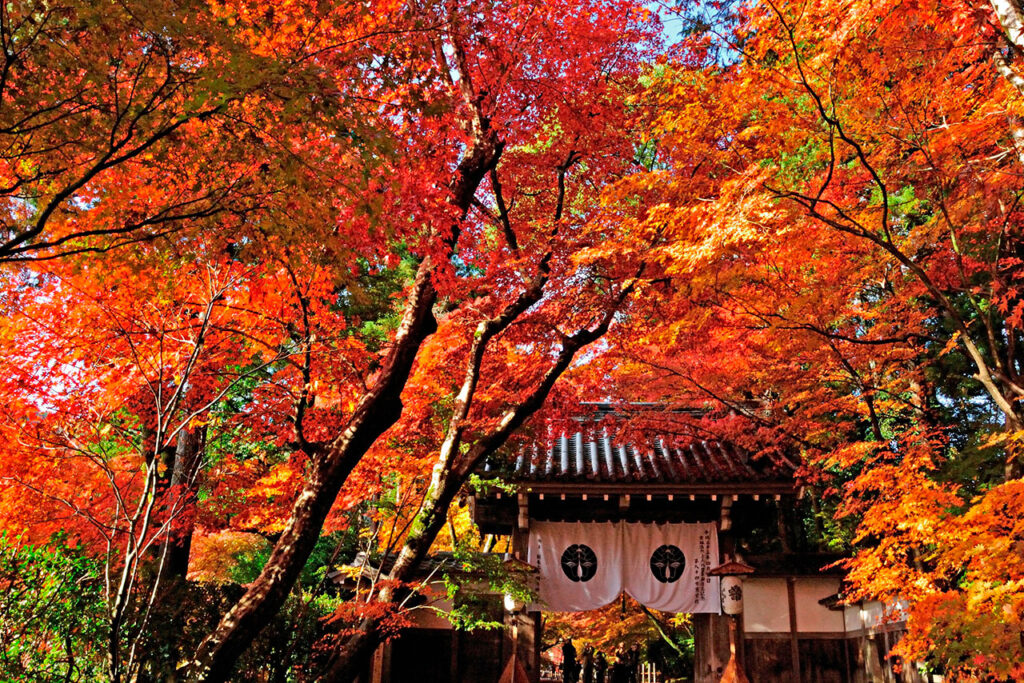

It is said that [Rikao-in] originated from the pagoda of Hodan-ji temple built by Ashikaga Yoshimitsu in 1379, and was the only pagoda that remained after the Onin War.
The approach that extends straight after passing through the temple gate is a highlight of the autumn leaves. You can walk through a tunnel of natural beauty, with branches spreading out on both sides of the elegant stone-paved approach to the shrine.
Best time to see/ Usually late November to early December
Visiting hours/9:00-17:00
admission fee/400 yen
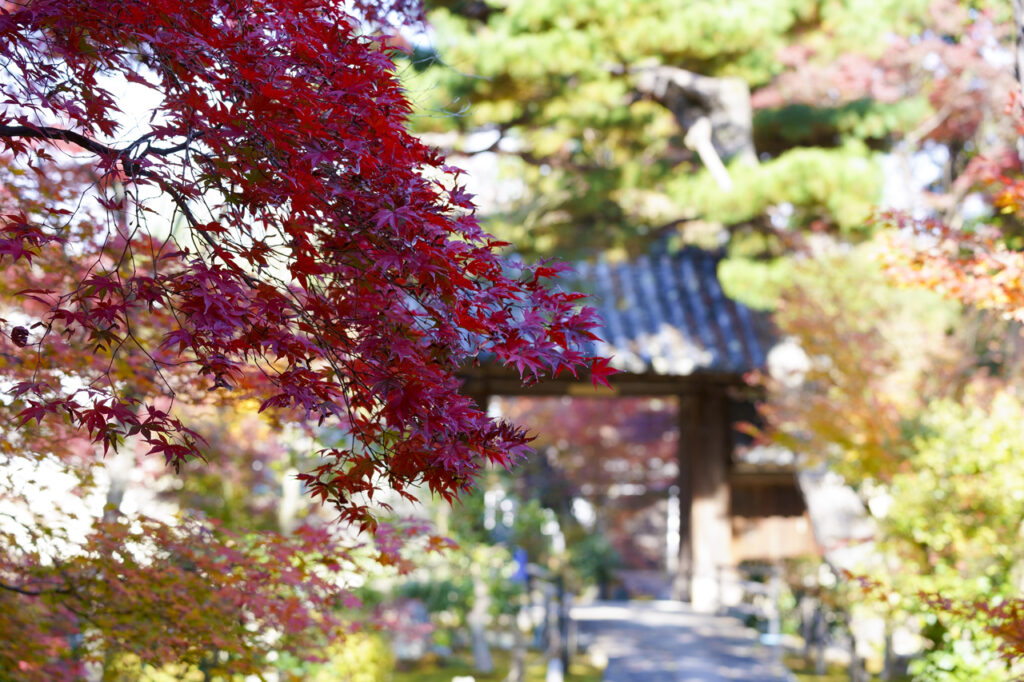

Bishamondō Hall] has a long history as a monzeki temple where Hōshinō serves as the head priest.
The sight of Chokushizaka turning red in autumn is a masterpiece. At the end of the slope is the Imperial Envoy Gate, which was given by Emperor Gosai and was completely relocated in 1693.
Best time to see/ Usually mid-November to early December
Visiting hours/ 9:00 - 17:00 (Reception close / 16:30)
admission fee/500 yen
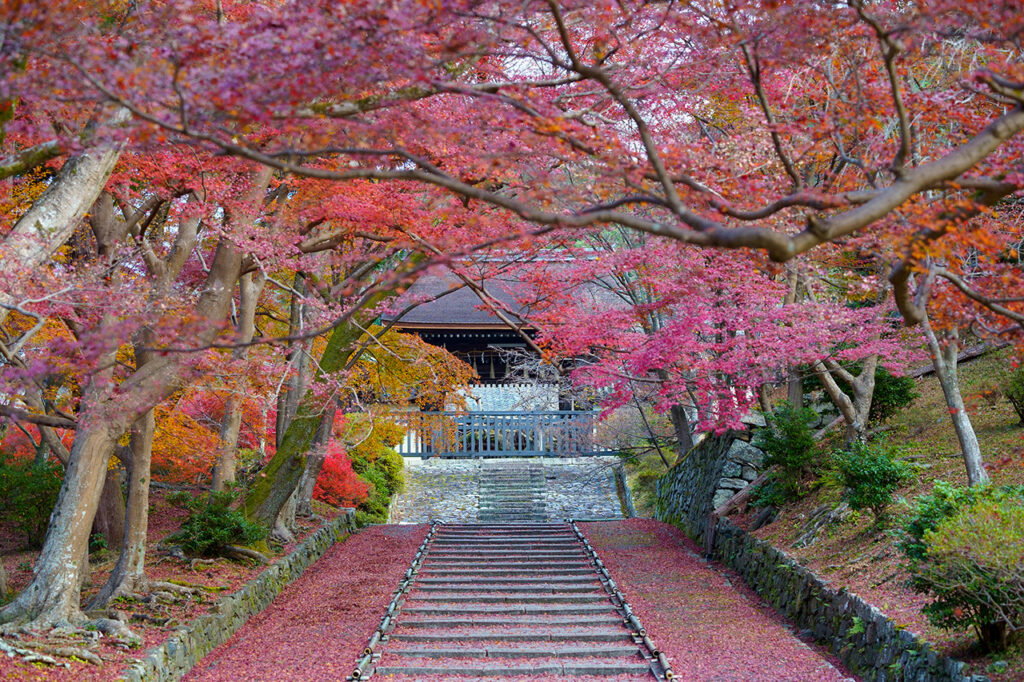

Toji Temple was founded as a temple to protect the nation.
The five-story pagoda, a national treasure, is one of the symbolic landscapes of Kyoto. It is also known for its autumn foliage, and the contrast between the five-story pagoda and the trees in red and yellow is a must-see. During the special nighttime viewing, the temple grounds are lit up and visitors can enjoy a fantastic scenery different from that of the daytime.
Best time to see/ Usually late November to early December
Visiting hours/ Kondo and Auditorium 8:00-17:00 (registration closes at 16:30),
Treasure House, Kanchiin 9:00 - 17:00 (reception ends at 16:30)
*Gates open from 5:00 to 17:00
admission feeFree admission to the Mikageido, dining hall, etc.
*Fees for paid areas vary depending on whether or not there is a special opening or special visit to the museum.
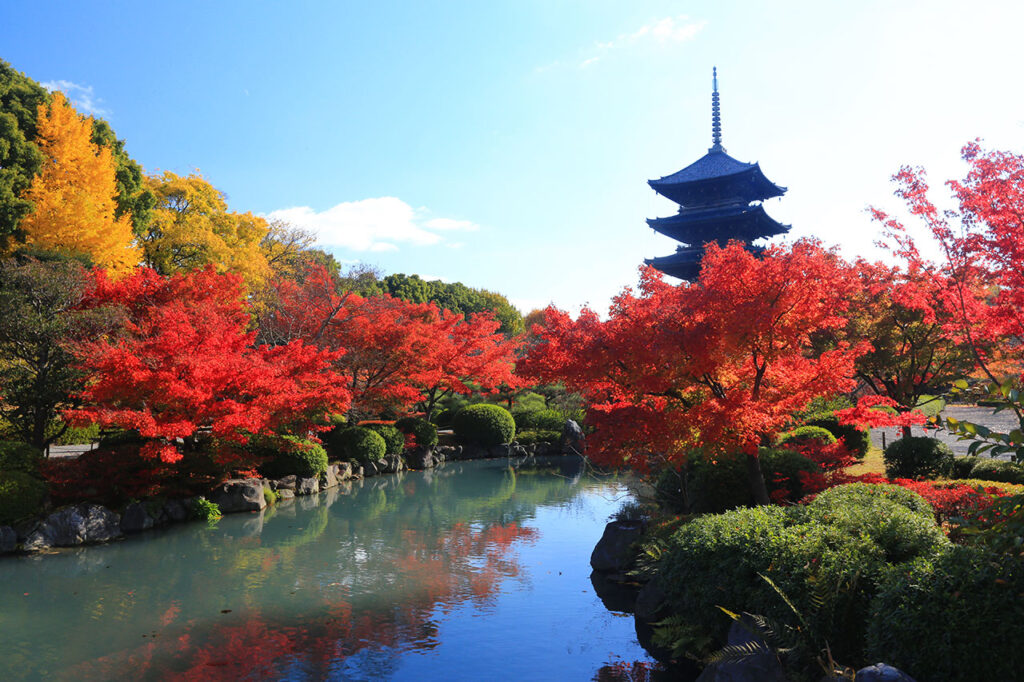

Umekoji Park is an urban oasis close to Kyoto Station.
Visitors can enjoy a leisurely stroll around Suzaku-no-niwa (Suzaku Garden) and the riverside playground while admiring the tree-lined avenues of autumn leaves. During the Umekoji Park Autumn Foliage Festival, Suzaku-no-niwa is illuminated, creating a fantastic atmosphere different from that of the daytime.
Best time to see/ Usually mid-November to early December
Entry Time/Free
9:00-17:00 for Suzaku Garden and Inochi-no-Mori (reception closes at 16:30)
no-holidayOpen 24 hours a day, 7 days a week
Suzaku Garden and Inochi-no-Mori are closed on Mondays (or the following weekday if Monday is a national holiday) and year-end and New Year holidays.
kindergarten enrollment feeFree of charge inside the park
Entrance fee for Suzaku Garden and Inochi-no-Mori (Forest of Life) is 200 yen.
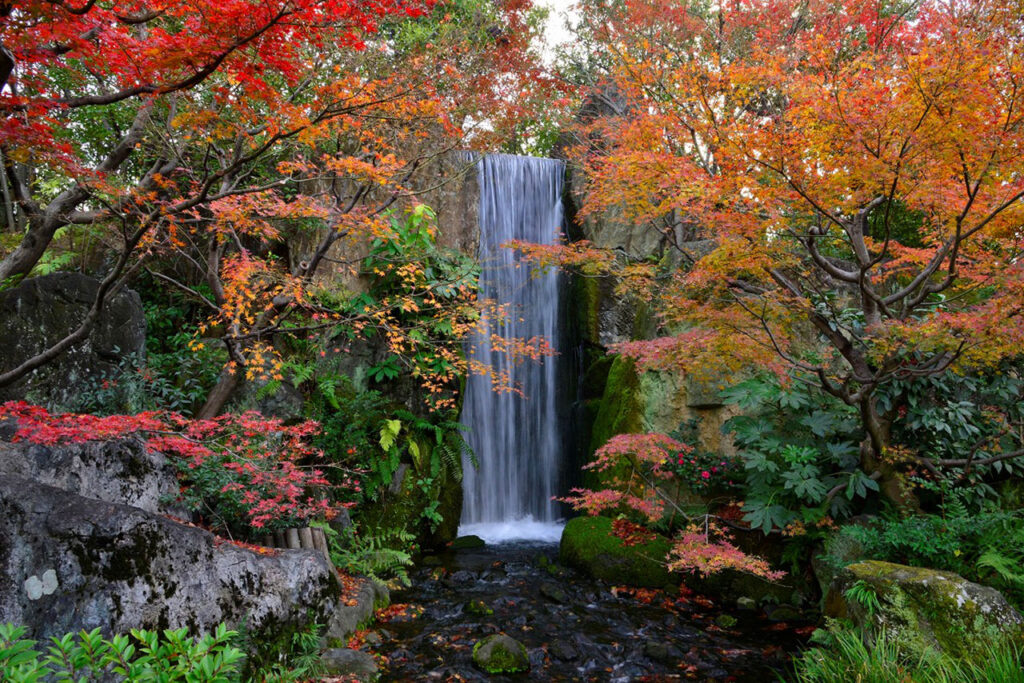
Taken in the Suzaku Garden

Kiyomizu Temple is one of the representative temples of Kyoto.
In December 2020, the first major renovation in half a century was completed, and the main hall and the stage of Kiyomizu were redecorated. 1,000 maple trees and mountain maples turn red in late November and early December. The grounds of the temple will be dyed in red from late November to early December. The contrast between the Okuno-in and the main hall, known as the Kiyomizu-no-butai, is a must-see. During the special nighttime viewing, the precincts are illuminated, creating an ethereal atmosphere.
Best time to see/ Usually late November to early December
Visiting hours/6:00-18:00 (subject to seasonal variations)
During special viewing, reception closes at 17:30 - 21:00 (gate closes at 21:30).
admission feeAdults (high school students and older) 400 yen, elementary and junior high school students 200 yen
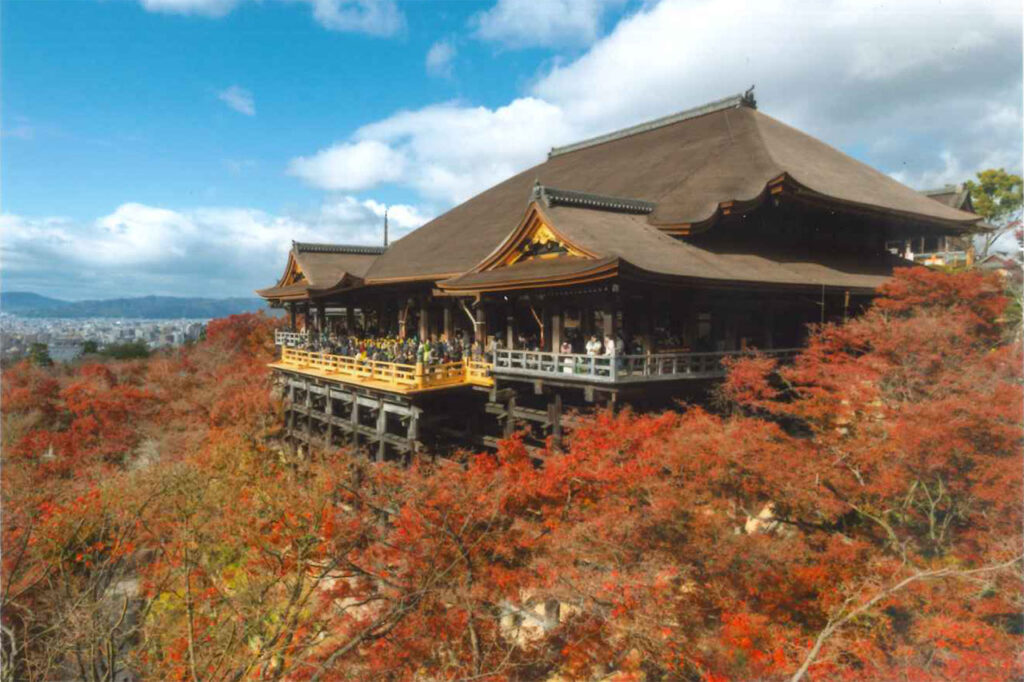

Kodai-ji Temple was built by Kotaisho, or Kita Masasho, the wife of Toyotomi Hideyoshi, as his family grave and his final resting place.
The temple is also famous for its autumn foliage, of which there are more than 1,000 trees on the grounds, and especially when illuminated, the fantastic reflection of the leaves in the mirror-like Garyu Pond is a sight not to be missed. During the special nighttime viewing period, the garden in front of the Hojo, called "Hashinniwa," will be specially decorated according to a theme, creating a different karesansui (dry landscape garden) than during the regular viewing period.
Best time to see/ Usually mid-November to early December
Visiting hours/9:00-17:30 (Reception close/17:00)
Special nighttime viewing period ~22:00 (reception closes at 21:30)
admission feeAdults 600 yen, Junior and senior high school students 250 yen, Kodaiji Temple (including Palm Art Museum) and Entokuin Temple common admission ticket 900 yen
* Free for elementary school students and younger when accompanied by an adult guardian (one guardian is required for every 10 children under elementary school age)
Free admission for those with a disability certificate and up to one accompanying person upon presentation of the certificate.
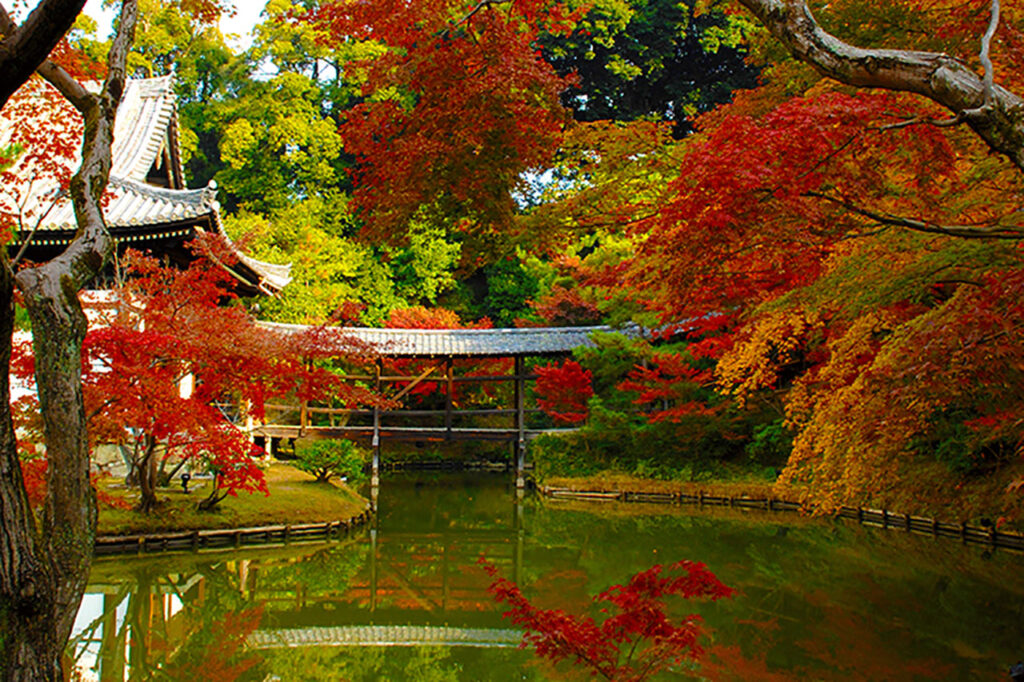

Kurodani Konkai Komyoji Temple was the birthplace of the Shinsengumi.
The best spot to enjoy the autumn foliage is around the three-story pagoda. The view of the tunnel of autumn leaves stretching from both sides of the hill and the three-story pagoda at the back of the tunnel is exceptional.
Best time to see/ Usually mid-November to early December
Visiting hours/9:00-17:00
admission fee/400 yen
Special Daytime Visits
Friday, November 12 - Sunday, December 5
9:00 - 16:30 (Registration closes at 16:00)
Mikageido, Daihojo and garden 1000yen
special night viewing
Friday, November 12 - Sunday, December 5
17:30 - 20:30 (Registration closes at 20:00)
Mikageido, Daihojo and garden 1000yen
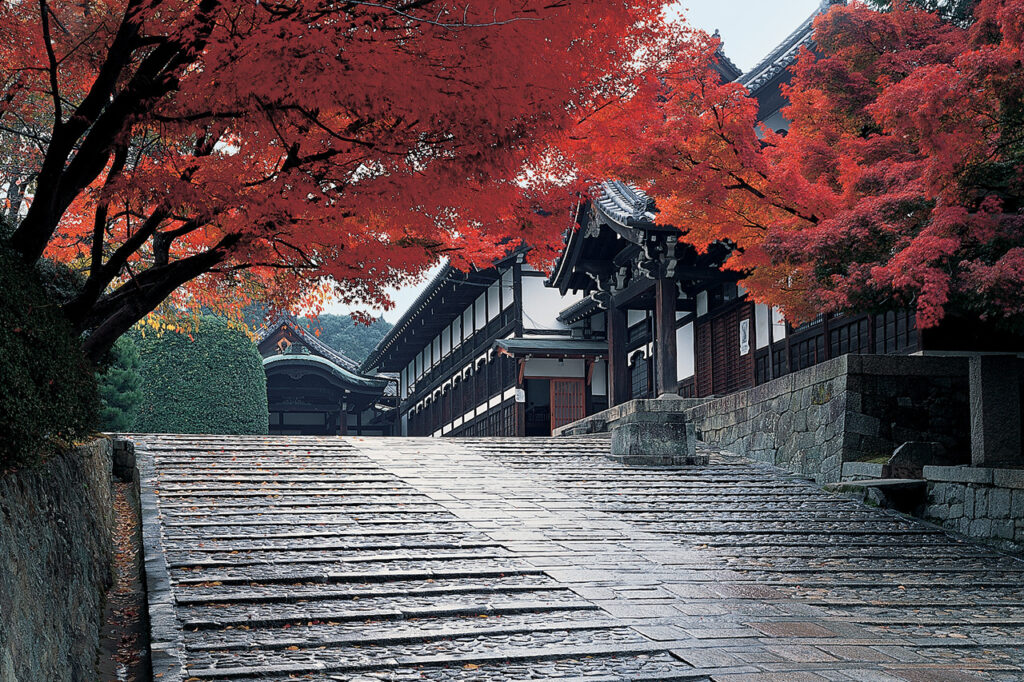
(C) Katsuhiko Mizuno

Nijo Castle was built by Tokugawa Ieyasu and has been the setting for numerous historical events.
The castle is also known for its autumn foliage, with a variety of trees, including ginkgo and maple, turning beautiful colors. From October 29 to December 12, "Nijo Castle Festival 2021" will be held, during which the castle will be brilliantly illuminated at night (from November 5) with lights and projection mapping.
*Details of the Nijo Castle Festival 2021 will be posted on the Nijo Castle website as soon as they are finalized.
Best time to see/ Usually mid-November to early December
opening hours (of a castle, etc.)/8:45-16:00 (Castle closes at 17:00)
The Honmaru Palace is currently undergoing conservation and repair work.
Reception Hours for Ninomaru Palace/8:45~16:10
day on which a castle is closed/December 29-31
Days when Ninomaru Palace is closed for viewing/Every Tuesday in January, July, August and December, December 26-28, January 1-3
*If the day in question is a holiday, the Ninomaru Palace may be viewed. However, on the following day, the Ninomaru Palace is closed to visitors.
Entrance fee (including the Ninomaru Palace entrance fee)General admission: 1030 yen, junior high and high school students: 350 yen, elementary school students: 200 yen
Exhibition and Storage Hall Admission100 yen per person per day
*Children under elementary school age are free
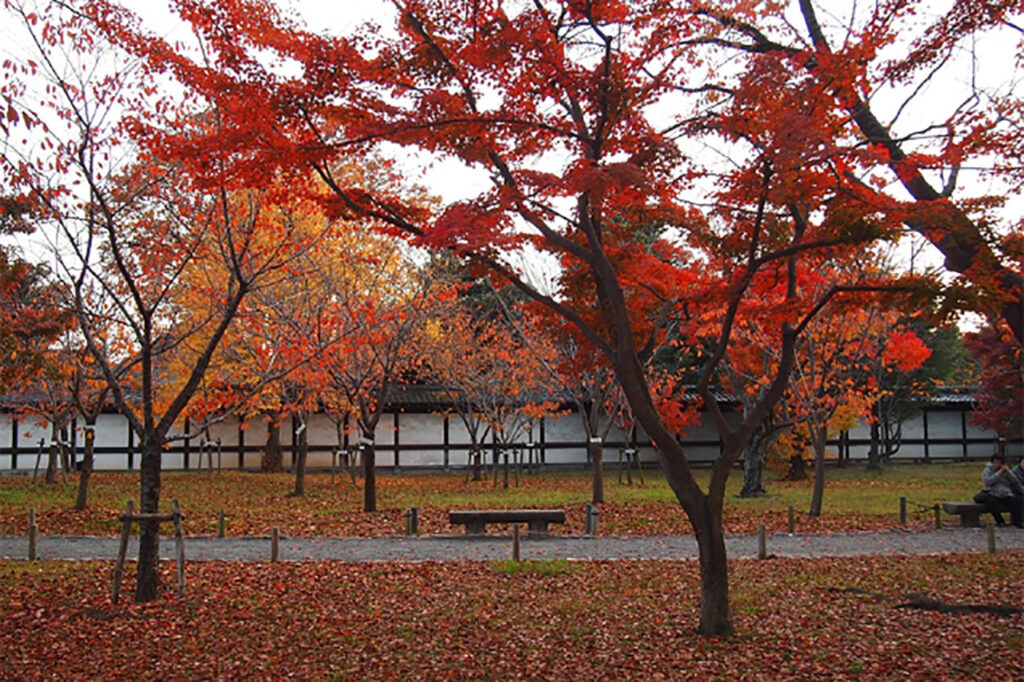

Kitano Tenmangu Shrine is the head shrine of Tenmangu Shrine and Tenjinsha throughout Japan, which enshrines Sugawara no Michizane, the god of learning.
On the west side of the precincts is a maple garden consisting of a natural forest and a part of the "Godoi," an earthen mound built by Toyotomi Hideyoshi, a feudal lord.
The view of approximately 350 autumn leaves changing colors and turning the surface of the Kamiya River, which runs north to south through the garden, red is breathtaking.
During the fall foliage season, the temple is illuminated to create an ethereal scene.
Best time to see/ Usually mid-November to early December
Tower gate and opening/closing hours/6:30 a.m. to 5:00 p.m.
Treasure House - Hours of Operation/9:00~16:00
The gate is open at night during the illumination of the maple garden and at New Year's.
admission feeFree of charge
Admission to the Treasure House (open on the 25th of each month and other days)Adults ¥800, Junior high and high school students ¥400, Children ¥250
Admission fee is required for Ume-en (plum garden), Midori no Ao-momiji (green maple leaves), and Maple Garden.
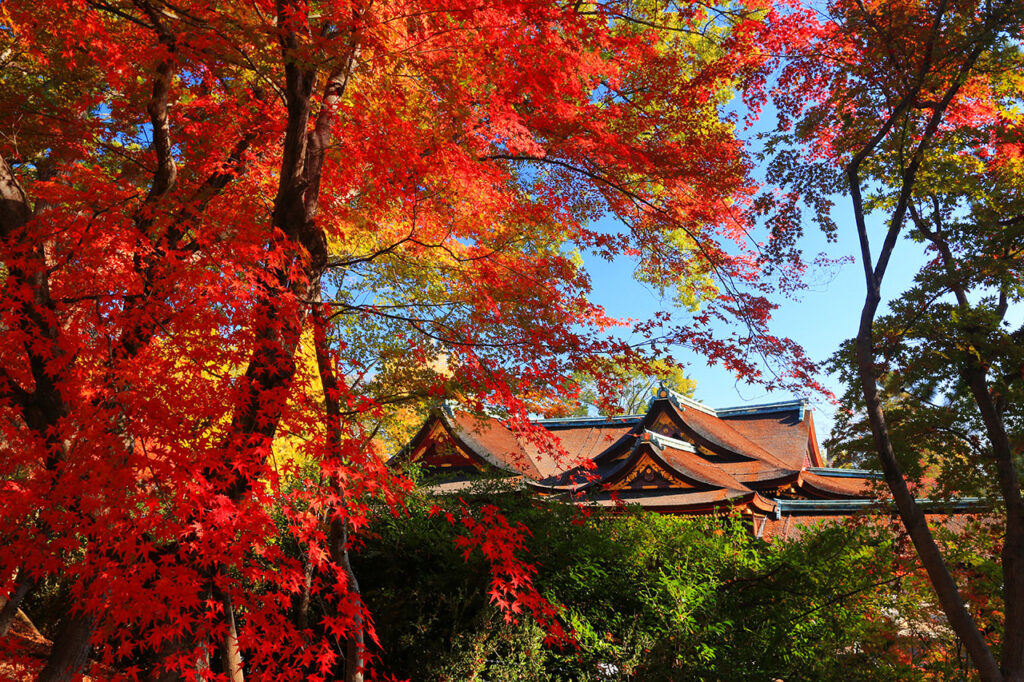

Myokenji Temple, located in a quiet residential area, is a little-known spot for autumn foliage.
The approach to the main hall from the main gate is greeted by autumn leaves and pine trees on both sides. They are arranged alternately, and the contrast between the green of the pine and the red of the autumn leaves is beautiful in autumn.
Best time to see/ Usually mid-November to early December
Visiting hours/10:00~16:00
admission fee/500 yen
Autumn Lighting/ November 13 (Saturday) - December 5 (Sunday)
18:00 - 20:30 (Registration closes at 20:00)
800 yen
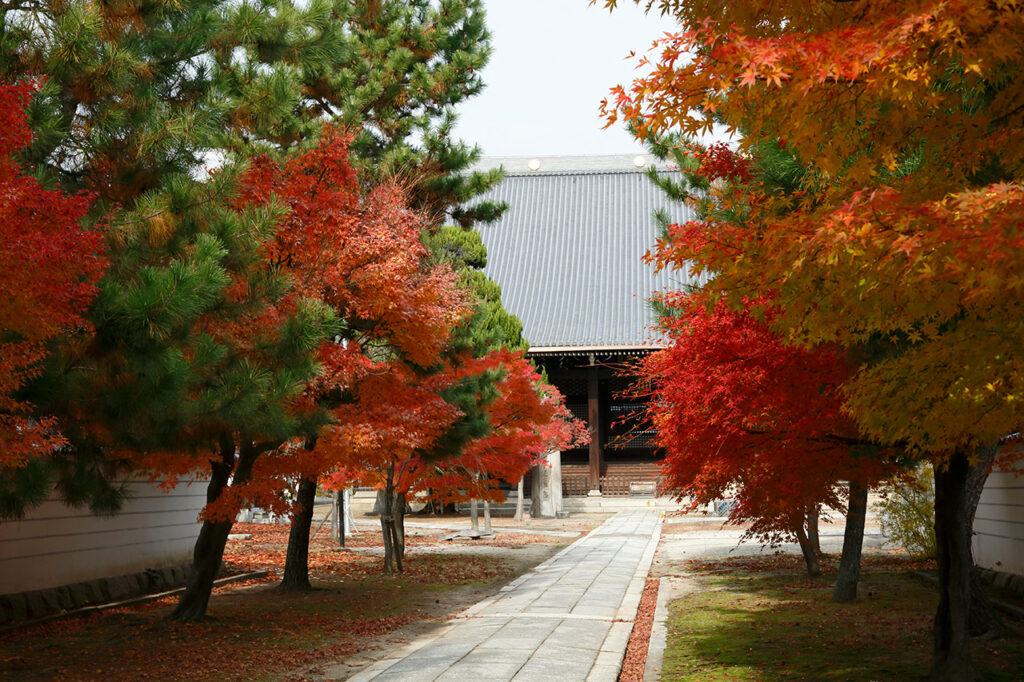

It is said that Hon'ami Koetsu established a hermitage on this land given to him by Tokugawa Ieyasu [Koetsu-ji Temple].
From the viewpoint 160 m above sea level, visitors can enjoy the autumn foliage of Takagamine Sanzan (three peaks of Takagamine, Washigamine, and Tengamine), which offer beautiful mountain views, and the 36 peaks of Higashiyama, where Kiyomizu Temple and Chion-in Temple stand at the foot of the mountain.
Best time to see/ Usually mid-November to early December
Visiting hours/ 8:00-17:00 (from 8:30 during autumn foliage season)
admission fee400 yen (500 yen during the season of autumn leaves)
Keishun-in Temple is the pagoda temple of Myoshin-ji Temple of the Rinzai sect of Zen Buddhism.
In autumn, visitors can enjoy the autumn leaves in Shinnyo-no-niwa, Wabi-no-niwa, Shiso-no-niwa, and Shoin, which was relocated from Nagahama Castle.
Best time to see/ Usually mid-November to early December
Visiting hours/9:00-17:00 (16:30 from November to February)
admission fee/400 yen
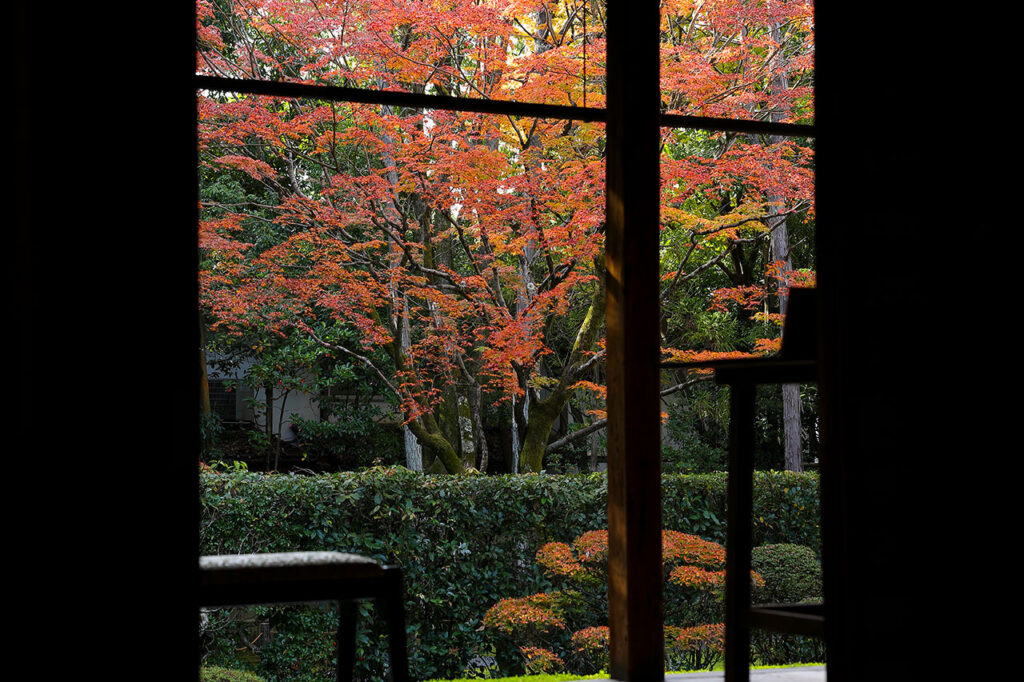

Daikakuji Temple, which still retains the atmosphere of the former imperial palace.
The vermilion-lacquered Shinkyō Hōto (treasure tower) and the surrounding maples reflected on the surface of Hōshō-ike Pond are beautiful and lustrous. The reflections of the maple trees on the surface of Osawa Pond, known as one of the three best places in Japan to view the moon, are also very atmospheric, and you can see various expressions of the autumn leaves.
Best time to see/ Usually mid-November to early December
Hours of Prayer/ 9:00 - 17:00 (Reception close / 16:30)
The hall area may be closed on certain days due to temple events.
Hall Area Entrance FeeAdults: 500 yen, Junior high and high school students: 300 yen
Oosawaike Pond Area Entrance FeeAdults: 300 yen, Junior high and high school students: 100 yen
*People with disabilities in any area,
Only those who present their passport will be exempted from paying the entrance fee.
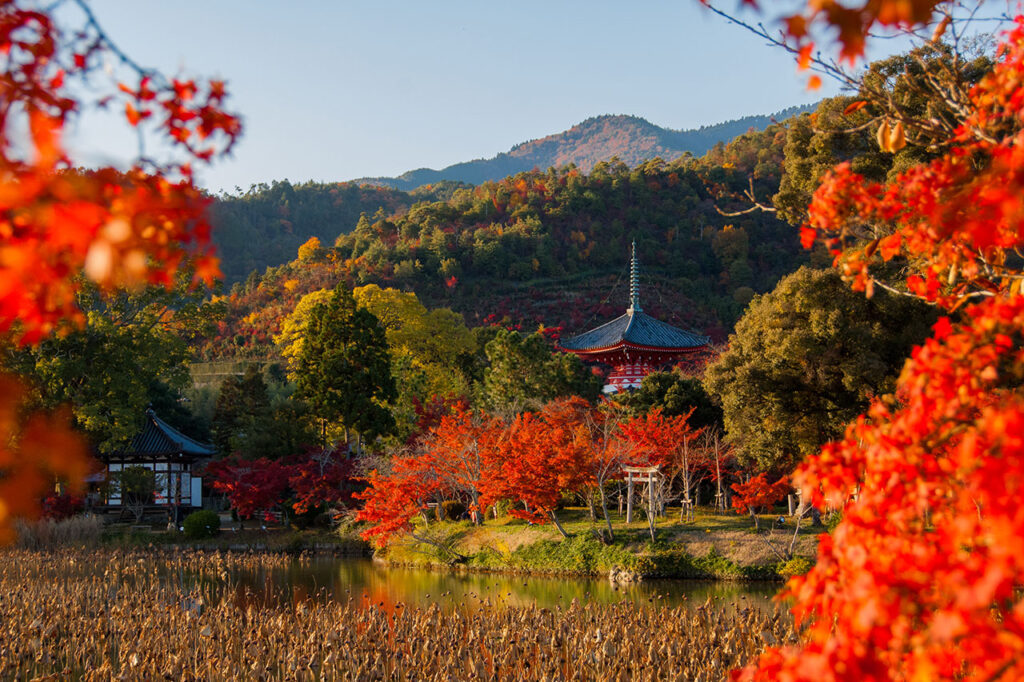

Ninna-ji Temple was founded by Emperor Uda in the early Heian period (794-1185) and has a strong connection with the imperial family.
The Omuro cherry blossoms are famous, but the autumn leaves that adorn the majestic five-story pagoda and other structures are also exceptionally beautiful. During the autumn foliage season, the pagoda is illuminated at night, creating a fantastic atmosphere.
Best time to see/ Usually mid-November to early December
Ninna-ji Temple Gosho Garden Hours/ Mar-Nov 9:00-17:00, Dec-Feb 9:00-16:00
Gosho Garden Visiting feeAdults 800 yen, High school students and younger free
Reihokan (limited time only) admission feeAdults: 500 yen, High school students and younger: free
Persons with a disability certificate are exempted from paying the entrance fee upon presentation of the certificate.
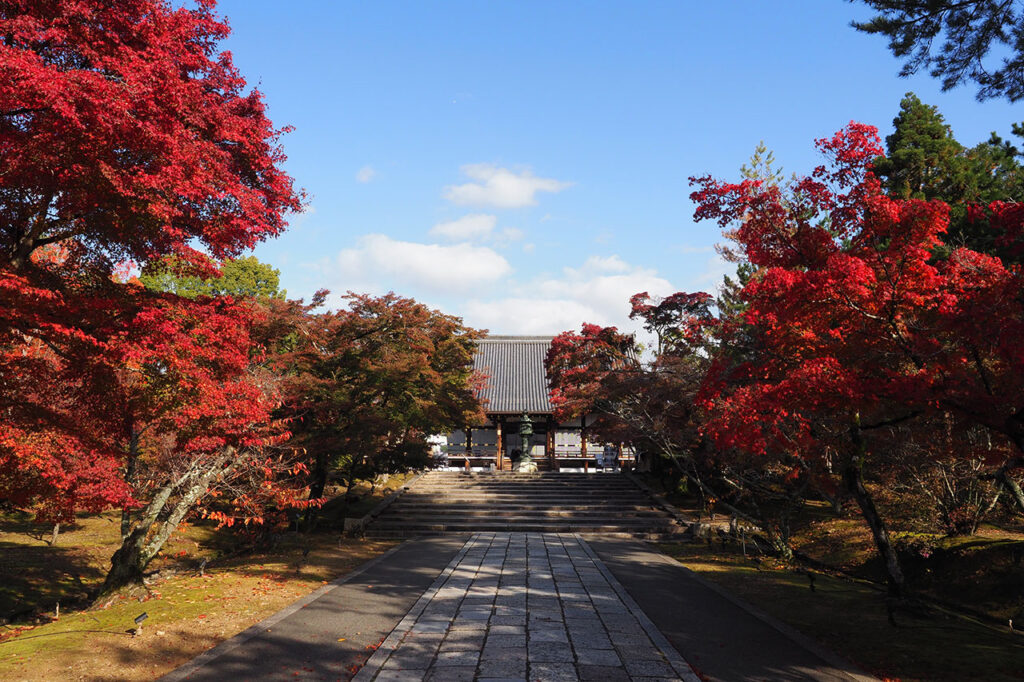

Jisso-in Temple, a monastery associated with the Imperial Family.
The magnificent stone garden "Kokoro-no-O-niwa" with the mountains of Hiei as a backdrop is in perfect harmony with the autumn leaves and the white sand. In the landscape garden with a backdrop of the mountain behind, visitors can enjoy a moment of tranquility while admiring the moss garden and the autumn leaves decorating the pond. The mysterious beauty of the floorboards in the waterfall room, known as "Toko-momiji" (floor maple leaves), which reflect the crimson maple leaves like a water mirror, is sure to captivate visitors.
Best time to see/ Usually mid-November to early December
Visiting hours9:00-17:00 (irregular holidays apply)
admission feeAdults: 500 yen, Junior high school and elementary school students: 250 yen
The gate will be closed on November 3 and 4.
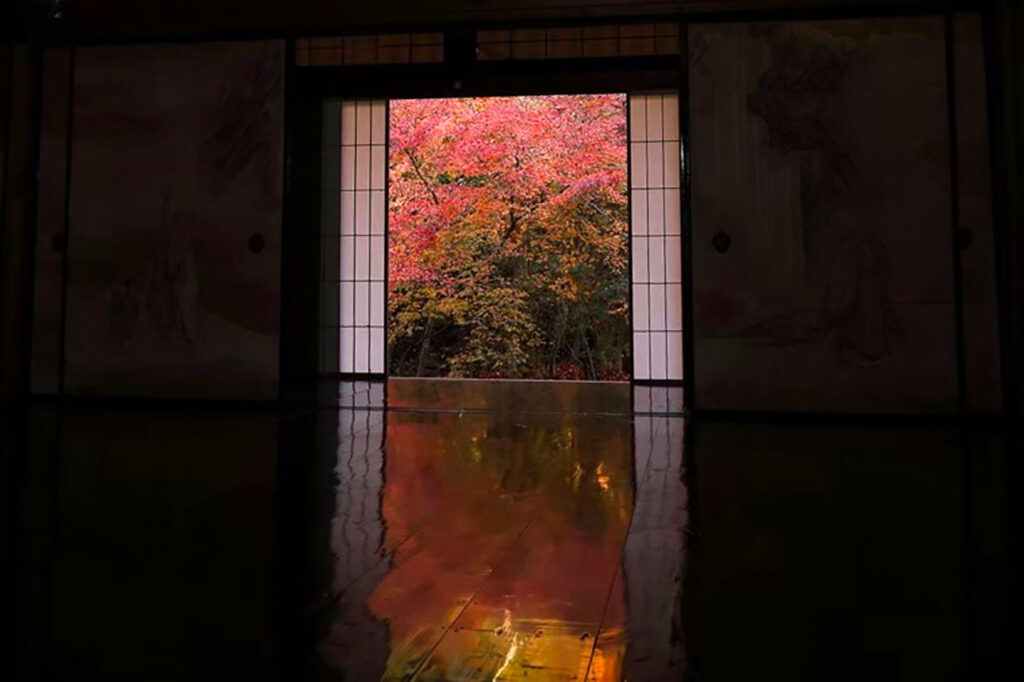

Kozanji Temple is famous as a national treasure for its caricatures of birds, animals, and people, and as a temple associated with the Buddhist priest Myoe.
From the porch of the national treasure Seoksuin Temple, visitors can enjoy a panoramic view of the autumn foliage of Mukoyama.
Best time to see/ Usually mid-November to early December
Visiting hours9:00-17:00 (last admission at 16:00)
mountain entry feeSeoksuin Temple is a separate admission fee of 800 yen.
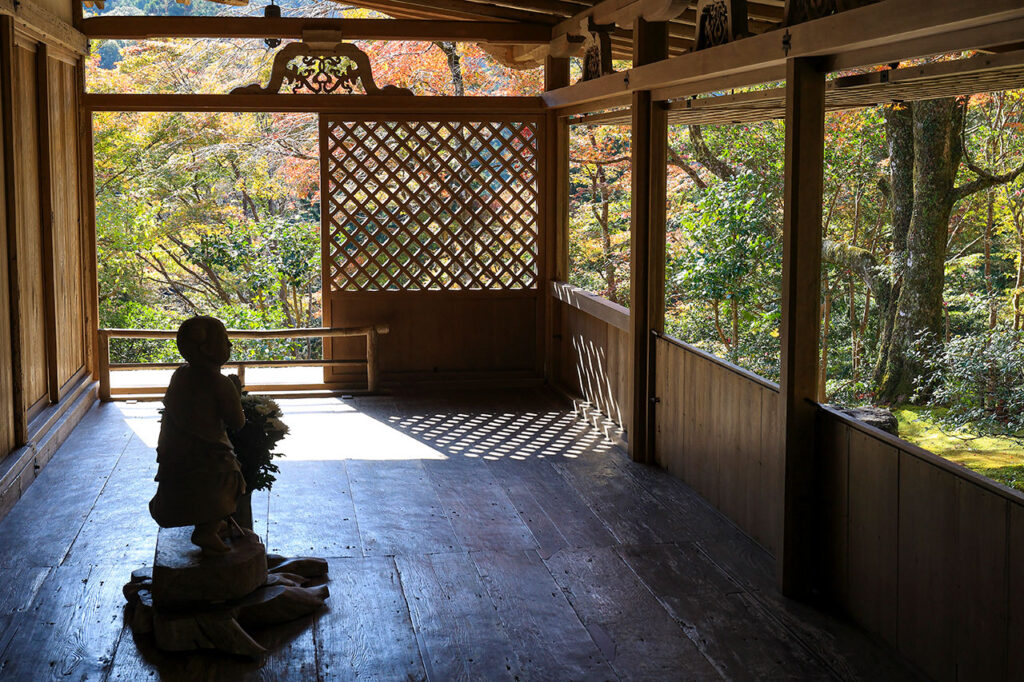

The Kyoto Botanical Garden opened in 1924 as Japan's first public botanical garden.
About 1,000 trees, including Irohamomiji and Ginkgo trees, turn brilliant colors, and visitors can enjoy a variety of autumn foliage for more than a month. The park will be illuminated from mid-November to early December.
Best time to see/ Usually mid-November to mid-December
opening hours (of a park, etc.)9:00-17:00 (last admission at 16:00)
Greenhouse Opening Hours/ 10:00-16:00 (last admission at 15:30)
* Closed from December 28th to January 4th
kindergarten enrolment fee200 yen, 150 yen for high school students, free for junior high school students and under
Greenhouse admission fee200 yen, 150 yen for high school students, free for junior high school students and under
Free admission to the park and greenhouse for those 70 years old or older with proof of age.
Admission, greenhouse admission and parking fees are free for those with a disability certificate (including caregivers) upon presentation of the certificate or Milairo ID.
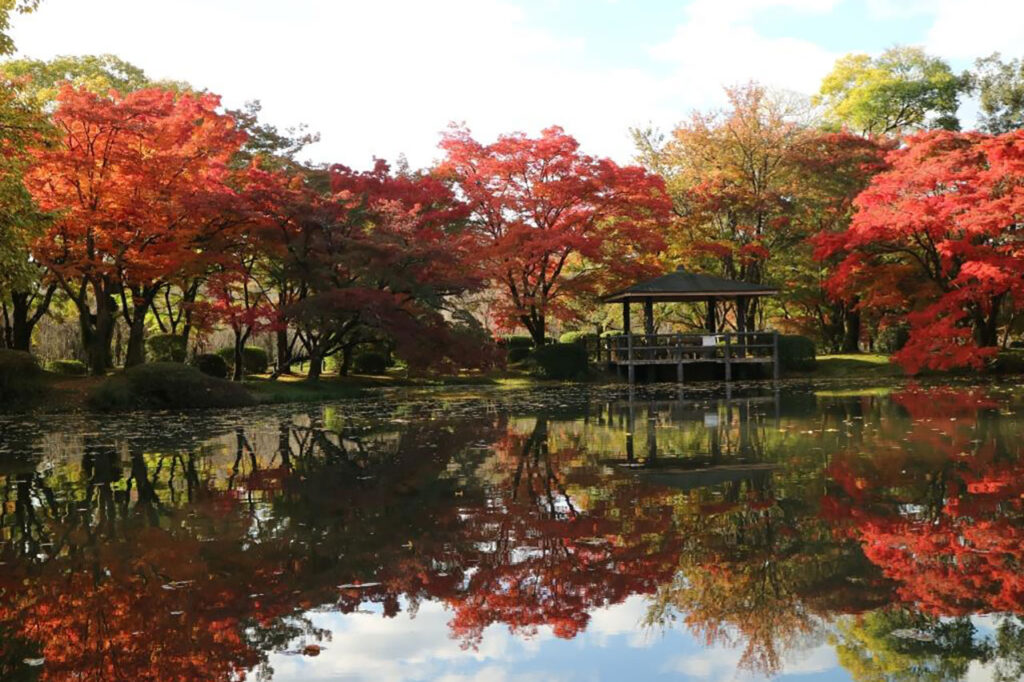

Shimogamo-jinja Shrine is the most historic power spot in Kyoto.
In the Tadasunomori forest, maple trees and zelkova trees turn the forest red and yellow. The best time to view the leaves is relatively late, from early to mid-December, so visitors can enjoy the autumn colors in a relaxed atmosphere.
Best time to see/usually early December to mid-December
Hours of Prayer/ 5:30-18:00 in summer, 6:30-17:00 in winter
*Open hours for special visits are 10:00-16:00
admission feeFree of charge on the premises
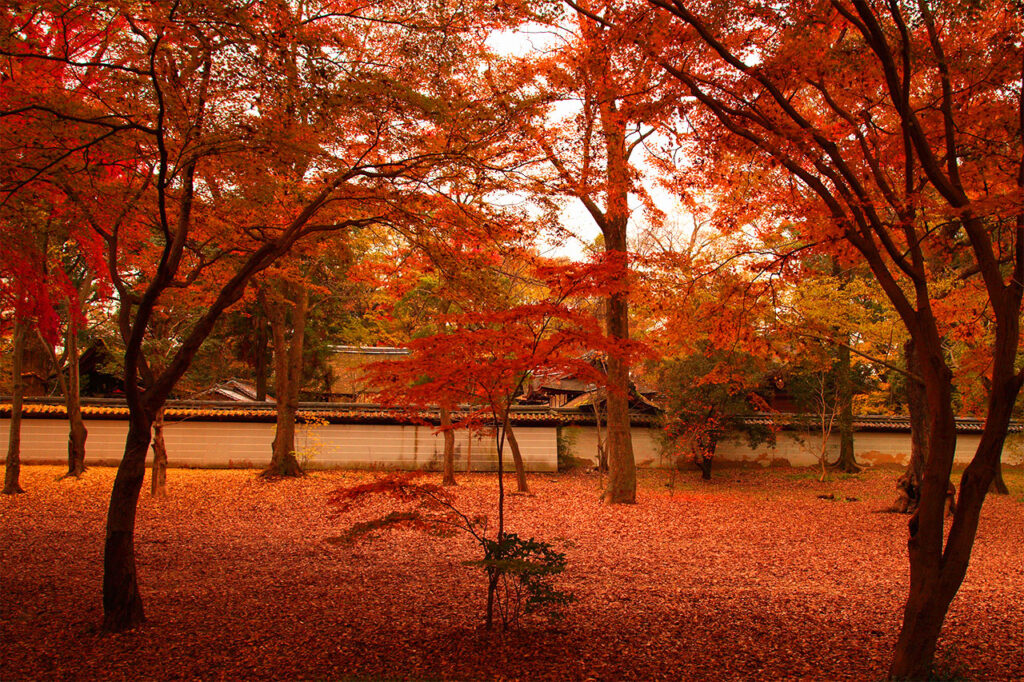

Over 600 interviews per year! An order site carefully selected by the editors who knows Kyoto and Shiga.
nowOfficial LINE friend registration500 yen OFF coupon is being issued!
Distributed every Friday morning at 8:00 am! From new restaurant information to event information that we want to share with you, We deliver articles about Kyoto that are useful to know. About 20,000 people have registered.Click here to add a friend!
 News
News Feature article
Feature article Featured event
Featured event